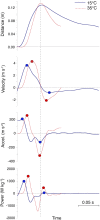Ballistic tongue projection in chameleons maintains high performance at low temperature
- PMID: 20212130
- PMCID: PMC2851764
- DOI: 10.1073/pnas.0910778107
Ballistic tongue projection in chameleons maintains high performance at low temperature
Abstract
Environmental temperature impacts the physical activity and ecology of ectothermic animals through its effects on muscle contractile physiology. Sprinting, swimming, and jumping performance of ectotherms decreases by at least 33% over a 10 degrees C drop, accompanied by a similar decline in muscle power. We propose that ballistic movements that are powered by recoil of elastic tissues are less thermally dependent than movements that rely on direct muscular power. We found that an elastically powered movement, ballistic tongue projection in chameleons, maintains high performance over a 20 degrees C range. Peak velocity and power decline by only 10%-19% with a 10 degrees C drop, compared to >42% for nonelastic, muscle-powered tongue retraction. These results indicate that the elastic recoil mechanism circumvents the constraints that low temperature imposes on muscle rate properties and thereby reduces the thermal dependence of tongue projection. We propose that organisms that use elastic recoil mechanisms for ecologically important movements such as feeding and locomotion may benefit from an expanded thermal niche.
Conflict of interest statement
The authors declare no conflict of interest.
Figures



References
-
- Herrel A, James RS, Van Damme R. Fight versus flight: Physiological basis for temperature-dependent behavioral shifts in lizards. J Exp Biol. 2007;210:1762–1767. - PubMed
-
- Huey RB, Bennett AF. Phylogenetic studies of coadaptation: Preferred temper-atures versus optimal performance temperatures of lizards. Evolution. 1987;41:1098–1115. - PubMed
-
- Bennett AF. Temperature and muscle. J Exp Biol. 1985;115:333–344. - PubMed
-
- Huey RB, Stevenson RD. Integrating thermal physiology and ecology of ectotherms: A discussion of approaches. Am Zool. 1979;19:357–366.
-
- Rome LC. Influence of temperature on muscle recruitment and muscle function in vivo. Am J Physiol. 1990;259:R210–R222. - PubMed
Publication types
MeSH terms
LinkOut - more resources
Full Text Sources

